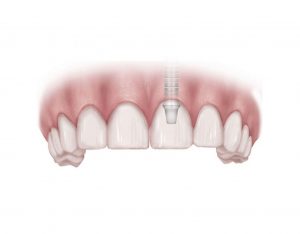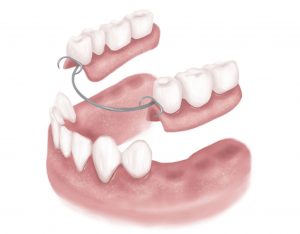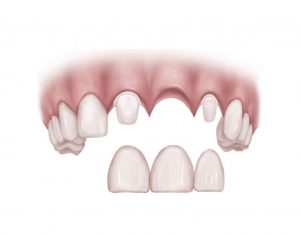Tooth Loss Impacts Remaining Teeth
When teeth are lost or removed, not only does the bone resorb, or deteriorate, but the surrounding teeth also begin to drift into the space created by the missing teeth. This results in a number of problems with the gums and how the teeth fit together and function.
Dental Implants Preserve Adjacent Teeth
Since dental implants serve as substitute tooth roots, providing a stable foundation for replacement teeth, there is no need to involve the adjacent teeth. Other methods of tooth replacement do not replace the missing tooth roots and therefore, require cutting down the adjacent teeth for a bridge, or hooking a partial denture onto other teeth, compromising the long-term health of those teeth.
Bridges Require Cutting Down the Adjacent Teeth
When teeth adjacent to the missing tooth are cut down into pegs for bridges, the enamel is removed, leaving the spongy layer of tooth structure called the dentin. Over time, the cement retaining the bridge washes out and bacteria can seep under the bridge and decays the dentin fairly quickly. This leads to failure of the bridge and possible root canals if the decay reaches the nerve.
Most importantly, once the teeth are cut down for a bridge, the tooth structure can never be replaced; the long-term health of the teeth is compromised and this usually results in additional treatment over time, which can be extensive and costly. Sometimes it is even necessary to cut down additional teeth to provide additional support when the teeth originally cut down to support the bridge fail.
In addition, these teeth now bear the forces that should normally be placed on three teeth, which further weakens the structure of these teeth. It’s rather like knocking one of the supports out from under the Golden Gate Bridge and expecting the other supports to bear the entire weight. It would simply fail as the other supports break down over time.
Partials Hook onto and Loosen the Adjacent Teeth
When teeth are replaced with a removable partial denture, the bone resorption is accelerated, as a result of the pressure on the gums and underlying bone. In addition, the pressure that the partial puts on the teeth that it is hooked onto begin to loosen.
Over time, the pressure can eventually torque these teeth out completely. If this happens, the partial must be made larger to incorporate the additional missing teeth/tooth, and it is now hooked onto other teeth than can be lost with continued pressure from the partial.
Dental Implants Actually Protect the Adjacent Teeth
When missing teeth are replaced with dental implants, there is no need to cut down the adjacent teeth, or hook a partial onto them, compromising the long-term health of the teeth. The dental implant serves as a replacement tooth root, supporting a new crown. This replicates the anatomy of the missing tooth as closely as possible. Additionally, there is an abundance of documented evidence in the scientific literature demonstrating that replacing teeth with dental implants actually protects the adjacent natural teeth.

An implant and crown replace the missing
tooth without compromising other teeth

A partial denture hooks onto the adjacent teeth
for support, loosening them over time.

Replacing a tooth with a bridge requires
cutting down the two adjacent teeth.